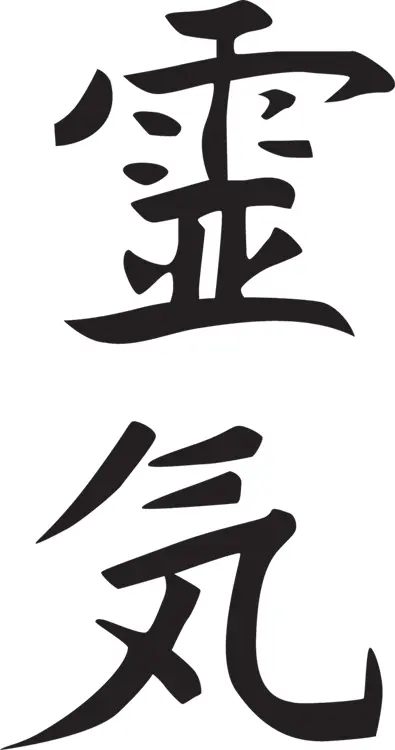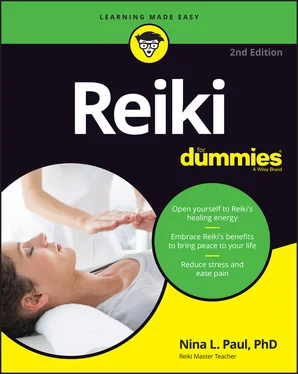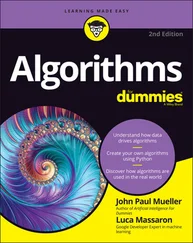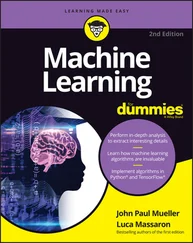You can always read from Chapter 1and continue onward, though I don’t assume that you’ll read every single chapter or that you’ll read the chapters in order. If you’re totally new to Reiki, I suggest starting with Chapter 1for an overview. Then you may want to jump to Chapters 5and 6to see what Reiki can do for you. I wish you peace and well-being with your Reiki journey.
Part 1
Getting Started with Reiki
IN THIS PART …
Check out basic information on what Reiki is and what it’s not. Reiki is a natural and simple way to achieve healing at all levels: physical, emotional, mental, and spiritual. Reiki is a Japanese word for “spiritual energy.”
Find out about the founders of Reiki. The system of Reiki has spread throughout the world since it was founded by Mikao Usui in Japan. As Reiki has evolved through changes made by different Reiki masters, it still retains its essence: to provide healing to all who seek it.
Discover the five underlying principles of Reiki and how this energy system compares and contrasts with other types of energy healing.
Chapter 1
Reiki: Connecting with Life-Force Energy
IN THIS CHAPTER
 Getting a basic idea of what Reiki is — and isn’t
Getting a basic idea of what Reiki is — and isn’t
 Finding out about the Reiki system
Finding out about the Reiki system
 Discovering the energy and origins of Reiki
Discovering the energy and origins of Reiki
 Seeing ways to experience Reiki
Seeing ways to experience Reiki
 Selecting a practitioner or teacher
Selecting a practitioner or teacher
 Listing the benefits of Reiki and revealing the symbols
Listing the benefits of Reiki and revealing the symbols
You’re deeply relaxed while lying on the Reiki table as the practitioner lays hands on different parts of your body. Impressed that this gentle laying on of hands can bring you such peace and joy, you want to know more about it. You’ve come to the right place. This book is a guide to the basic practice of Reiki.
This book describes how to use Reiki to heal yourself and your family members and even treat people who are far away. Reiki techniques can also be used for your pets, your food, and the earth. The more you use Reiki, the more uses you’ll find for it. In this chapter, you find out how Reiki works, where Reiki comes from, and what help Reiki can give you. You can even discover how to channel the Reiki energy yourself so that you have a lifelong tool to use for yourself and others. You get a taste of what Reiki is all about in these next several pages.
Discovering What Reiki Is and Isn’t
Reiki is both of the following:
A healing system that channels universal life-force energy: Mikao Usui originally developed this system in the early 1900s in Japan. For more on Reiki’s beginning, see the later section “ Exploring the History of Reiki” as well as Chapter 3.
The name of the energy itself: Rei means spiritual wisdom, and ki means energy, so Reiki means spiritual energy. See Figure 1-1, which illustrates the word Reiki in Japanese characters.
 Because Reiki originated in Japan, you can understand many of its concepts and terms more deeply when you consider the language and culture in Japan in the early 1900s. If you’re interested in studying more about the language or culture of Japan, start by looking at some of the resources in Appendix A.
Because Reiki originated in Japan, you can understand many of its concepts and terms more deeply when you consider the language and culture in Japan in the early 1900s. If you’re interested in studying more about the language or culture of Japan, start by looking at some of the resources in Appendix A.
 Reiki is available to everyone. Anyone of any age or level of health can receive Reiki. Even newborn babies or people at the end of life can benefit from the relaxation that it provides. See Chapter 6to find out how every member of your family, including your pets, can use and benefit from Reiki.
Reiki is available to everyone. Anyone of any age or level of health can receive Reiki. Even newborn babies or people at the end of life can benefit from the relaxation that it provides. See Chapter 6to find out how every member of your family, including your pets, can use and benefit from Reiki.
 As an intelligent energy, Reiki gives you what you need, whether it’s a release of tension, an energy boost, or both. To help you more fully understand what Reiki gives you, here are some terms used to describe Reiki:
As an intelligent energy, Reiki gives you what you need, whether it’s a release of tension, an energy boost, or both. To help you more fully understand what Reiki gives you, here are some terms used to describe Reiki:
Gentle: Reiki’s touch is soft and light.
Harmless: Reiki can have only positive results.
Natural: You don’t need any equipment or tools.
Healing: Reiki’s goal is to bring forth the highest level of healing.
Balancing: Reiki balances your energy levels.
Relaxing: The top reason to try Reiki is to feel the bliss of deep relaxation.
Energizing: If you’re drained of energy, Reiki can revive you.

© John Wiley & Sons, Inc.
FIGURE 1-1:The Japanese characters for Reiki.
Knowing what Reiki isn’t is as important as knowing what it is:
Reiki isn’t religious. Reiki is nondenominational. You can practice any religion (or none) and still use and benefit from Reiki. Mikao Usui was influenced by the religions of his country, Shintoism and Buddhism. But Reiki isn’t associated with any religion, and people of all faiths and beliefs are Reiki practitioners. Reiki isn’t New Age either, though Reiki can be used alongside any spiritual belief or religious system.
Reiki isn’t massage or reflexology. Reiki is an energy-healing system and not a manipulative system (hands manipulating the body). Reiki is distinct from reflexology and massage, but it can be used alongside these and other healing arts.
 Reiki isn’t the personal energy of the practitioner but the energy from the universe transmitted through the practitioner.
Reiki isn’t the personal energy of the practitioner but the energy from the universe transmitted through the practitioner.
Describing the System of Reiki
Reiki is a system of connecting to, transmitting, and receiving the Reiki energy.
Connection to Reiki energy is made through
Reiki Principles (see Chapter 4)
Reiki symbols (see Chapter 8)
Prayer and meditation (see Chapter 9)
Reiki is transmitted through
The hands
The eyes
The breath
The energy can be transmitted through gentle touch, be beamed across the room, or be sent by distance through techniques for distance healing (see Chapters 11and 15). The ability to be a conduit for Reiki energy is taught through Reiki classes. (See the later section “ Taking Reiki classes” as well as Chapter 7.)
 For receiving, all one needs to do is relax and be open. You probably know how to receive the energy from the sun, from a friend or family member or a pet, or from a forest or body of water. Reiki is the same.
For receiving, all one needs to do is relax and be open. You probably know how to receive the energy from the sun, from a friend or family member or a pet, or from a forest or body of water. Reiki is the same.
Читать дальше

 Getting a basic idea of what Reiki is — and isn’t
Getting a basic idea of what Reiki is — and isn’t Because Reiki originated in Japan, you can understand many of its concepts and terms more deeply when you consider the language and culture in Japan in the early 1900s. If you’re interested in studying more about the language or culture of Japan, start by looking at some of the resources in Appendix A.
Because Reiki originated in Japan, you can understand many of its concepts and terms more deeply when you consider the language and culture in Japan in the early 1900s. If you’re interested in studying more about the language or culture of Japan, start by looking at some of the resources in Appendix A. Reiki is available to everyone. Anyone of any age or level of health can receive Reiki. Even newborn babies or people at the end of life can benefit from the relaxation that it provides. See Chapter 6to find out how every member of your family, including your pets, can use and benefit from Reiki.
Reiki is available to everyone. Anyone of any age or level of health can receive Reiki. Even newborn babies or people at the end of life can benefit from the relaxation that it provides. See Chapter 6to find out how every member of your family, including your pets, can use and benefit from Reiki.











